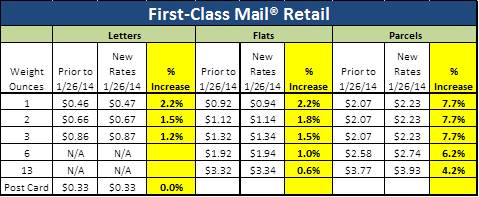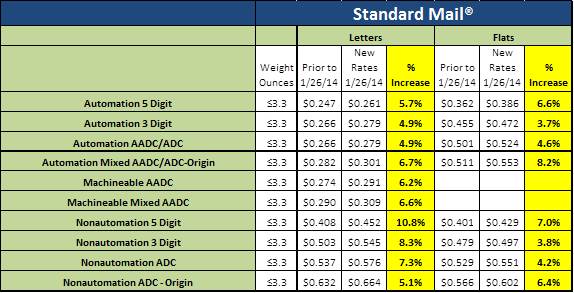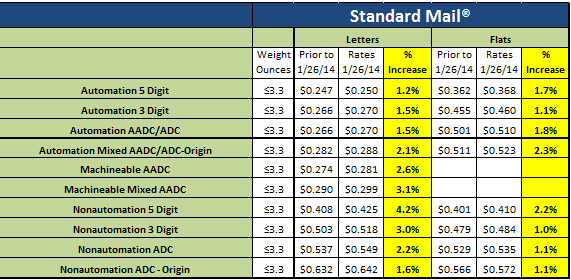In most years, the proposed rate increase is pretty simple. The rates go up in the 2-4% range and are tied to the Consumer Price Index. This year there are two proposals and one of them could have a huge impact on budgets.
· Exigent Rate Increase--4.3% Average (3-12% based on class and service)
· Non Exigent Rate Increase -- 1.6% Average (0-7.7% based on class and service)
Let us start out by saying these are the proposed rates that are to go into effect on January 24, 2014. The Postal Regulatory Commission has a comments period that extends until December 6, 2013 where these recommendations could be modified.
Postal rates are supposed to be tied to the Consumer Price Index which today is running in the 1-2% range. The USPS needs their rates to be in line with this index except in the following circumstances:
1. Unused Rate Adjustment -- They did not adjust past rates to the full levels allowed.
2. Exigent Circumstances - They have drastic conditions that require them to raise rates to higher levels. This is our big worry because anyone could argue that we have justification for larger increases.
For the past 16 years, I have been creating comparison charts for my clients that go over the changes in rates to show how it will affect their budgets. The reason that I do this is that when the USPS talks about a 1.6 or 4.3% increase, this is overall. Based on the type of mail you do, the increase could be higher or lower. You need to look at the class, weight, zone, density and special services required to see the true impact. Also, when you look at the new rate charts provided by the USPS, they typically will not show the level of detail needed (Previous and new rates side by side) to see these differences.
The remainder of this article is to pull out areas where the increases are going to be higher or lower than the averages and how the changes will affect you.
First-Class Mail® Retail
Exigent Increase -- 3-12.1%
· Exigent Rate Increase--4.3% Average (3-12% based on class and service)
· Non Exigent Rate Increase -- 1.6% Average (0-7.7% based on class and service)
Let us start out by saying these are the proposed rates that are to go into effect on January 24, 2014. The Postal Regulatory Commission has a comments period that extends until December 6, 2013 where these recommendations could be modified.
Postal rates are supposed to be tied to the Consumer Price Index which today is running in the 1-2% range. The USPS needs their rates to be in line with this index except in the following circumstances:
1. Unused Rate Adjustment -- They did not adjust past rates to the full levels allowed.
2. Exigent Circumstances - They have drastic conditions that require them to raise rates to higher levels. This is our big worry because anyone could argue that we have justification for larger increases.
For the past 16 years, I have been creating comparison charts for my clients that go over the changes in rates to show how it will affect their budgets. The reason that I do this is that when the USPS talks about a 1.6 or 4.3% increase, this is overall. Based on the type of mail you do, the increase could be higher or lower. You need to look at the class, weight, zone, density and special services required to see the true impact. Also, when you look at the new rate charts provided by the USPS, they typically will not show the level of detail needed (Previous and new rates side by side) to see these differences.
The remainder of this article is to pull out areas where the increases are going to be higher or lower than the averages and how the changes will affect you.
First-Class Mail® Retail
Exigent Increase -- 3-12.1%

Non Exigent Increase - 0-7.7%

This could be a big impact for many entities. With the Exigent Increase, not only do the first ounce rates increase significantly, but the second ounce rates go up as well from $.20 to $.21 ($.17 to $.18 for Parcels). Regardless of which is approved, you can clearly see the largest increases are for the lightest weight items. Finally, parcels are going up at the highest rates. My guess is because they are still a bargain compared to the private carriers.
There is an interesting item in both proposals where there is a different rate category for Single Piece Metered Letters where they are giving a $.01 discount. It seems that they are giving this rate break if you use a postage meter instead of a stamp. It is unclear if this will apply to PC postage but this could be a great thing for the postage meter industry. It is interesting to note that if this is passed, and only the Non Exigent proposal goes through, then letter rates for postage meter users would not increase.
Commercial
Exigent Increase -- 4.3-11.1%

Non Exigent Increase - 0-3.2%

Automation 5 Digit Flats are having some of the largest increases. This looks like the USPS realized they were giving too deep a discount for these items compared to the other sort levels. My guess is that we will continue to see the largest increases in this category. If you are using a presort service, this may affect the rates they are charging.
Standard Mail®
Exigent Increase -- 3.8-10.8%
Standard Mail®
Exigent Increase -- 3.8-10.8%

Non Exigent Increase - 1-4.2%

· It is interesting that when you look at the Exigent increases for both Standard Mail® and Non Profit, the largest increases are at the 5 Digit and Mixed AADC levels.
· Non automation rates seem to be going up at higher levels than automation for both Standard Mail® and Non Profit with the largest increases happening at the 5 Digit levels.
Exigent Increase -- 3-12.8%
· Non automation rates seem to be going up at higher levels than automation for both Standard Mail® and Non Profit with the largest increases happening at the 5 Digit levels.
Exigent Increase -- 3-12.8%

Non Exigent Increase - .7-5.1%

Special Services
Exigent Increase -- 0-16.7%

Non Exigent Increase - 0-11%

One item that I wanted to pull out was the cost of doing a Piece of Certified Mail with Return Receipt. Under both proposals the price will now be $6.22 - $6.49 for a one ounce letter. At that price, it may be a good idea to check your 2-3 day rates with your private carriers to see if they may be less money. Also, consider switching to the Electronic Return Receipt which saves $1.30-1.32 each.
Conclusion Because this rate increase is such an unknown right now, if you need to do budgeting for next year, and you are going to assume your mail volumes will stay the same, I would add a 6% increase to be safe. It is impossible to compare every rate but these are the most common mail classes used by business mailers throughout the United States. I hope this type of comparison is helpful and we will be posting the final rates as soon as they are available on www.postaladvocate.com.
Adam Lewenberg, CMDSS, MDC, is President of Postal Advocate Inc., runs the largest Mail Audit and Recovery firm in the United States. Their mission is to help entities with large numbers of locations reduce mail related expenses, recover lost postage funds, and simplify visibility and oversight. He can be reached at (617)372-6853 or adam.lewenberg@postaladvocate.com.
Conclusion
Adam Lewenberg, CMDSS, MDC, is President of Postal Advocate Inc., runs the largest Mail Audit and Recovery firm in the United States. Their mission is to help entities with large numbers of locations reduce mail related expenses, recover lost postage funds, and simplify visibility and oversight. He can be reached at (617)372-6853 or adam.lewenberg@postaladvocate.com.










